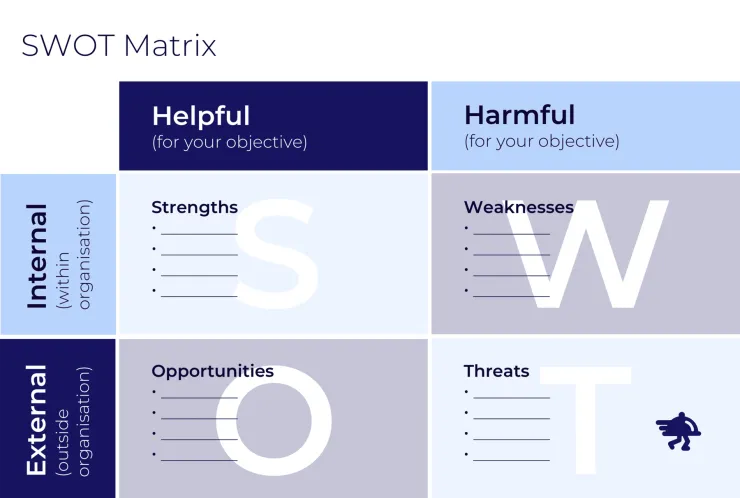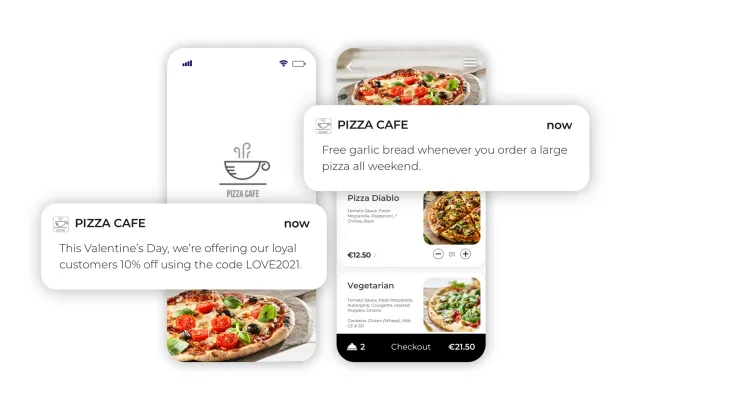Whether you plan to open a restaurant, already have opened a restaurant, have just accepted a job as head of marketing for a growing chain, three questions should be top of mind for your restaurant marketing plan:
How do I acquire new customers?
How do I keep them?
How do I encourage them to visit as often as possible?
Let’s face it, if you can’t answer these questions, you are likely to run into some serious problems. And at the highest possible level, answering these questions is the job of your restaurant marketing plan.
Why create a restaurant marketing plan
Before going further, I want to expand a little more on the ‘why’ of writing a restaurant marketing plan, because when we understand the purpose of a plan like this, we will immediately have a much clearer understanding of what to put in it.
A marketing plan ultimately enables you to do two things:
Execute on a clear set of strategies that you can be confident will help deliver on the objectives set out at the start of this piece
Help you evaluate new potential activities and courses of action through a critical lens and say ‘yes’ and ‘no’ effectively
The former point is relatively well understood. The latter point is less so. But it is the difference between a marketing plan as a laundry list of things that sound good and that ‘other restaurants do’. This document helps provide a strategic direction and ensures all activity is pulling in the same direction and moving the business to where you want it to be.
I’ll talk a bit more about this later. But for now, let’s get right into the practicalities of creating a plan that will work for you.

Creating a restaurant marketing plan: step by step guide
Firstly, it’s important not to be intimidated by the idea of creating a marketing plan. It’s not being created for the benefit of a third party, it is being created for you. Don’t let concern about doing it perfectly or ‘the right way’ stop you doing the basics. Because even if you end up with two pages that clearly outline a strategy in simple English, that is almost certainly better than nothing.
With that out of the way, let’s talk about what you want to see on the page after you’ve finished, which is something like this:
A mission or purpose statement
A positioning statement (or elevator pitch)
A SWOT analysis of your business and the local competition
An outline of your target audience and their habits
A set of activities, grouped under simple headings, that you are proposing to implement
That, ultimately, is about it. But as you might expect, each of these simple-sounding bullets could be expanded into a book! Don’t panic, I won’t do that here. But let’s take a closer look at each in turn.
A mission or purpose statement
Millions of well-meaning words have been written about purpose, mission, vision and other similar statements. And with the best will in the world, most of them probably cause more confusion than clarity for the average owner of a growing business. Let’s simplify.
A purpose statement is simply a brief statement, written in plain English (or whatever your native language happens to be), that describes why your business exists. That’s it. Although you wouldn’t normally share a purpose statement publicly, in order to give you an example this is what we use at Flipdish:
To empower a world of diverse, independent food businesses.
If you have ambitions for your brand, you will want to create something similar. It could be something incredibly simple like “to provide the best Vietnamese food, using the best and freshest ingredients, in London”. That is more than enough. A statement like this gives focus to the business, it helps you evaluate potential courses of action, and it means you have something on which to build a brand. Which brings us to our next section.
1. A positioning statement
Quite simply, a positioning statement describes what you want your target audience to think about you. Another way to put this would be to ask the question: “what do I need people to believe about my business that will make them want to become customers — and keep them coming back?”.
Some of the most successful brands in the world are founded on simple answers to this question. I don’t have access to the actual statements themselves but I suspect “Volvo make safe cars” and “Ryanair sell cheap flights” aren’t a million miles off the truth.
Your positioning statement will work in the same way, and inform your marketing in the same way. Simply put, it becomes the thing you need to keep talking about. Remember, every business benefits from building a memorable brand, and building a memorable brand means being focused on communicating a core set of messages.
By writing it down in this way, and referring back to it, you’ll make everything you do more effective.
Sidenote: your positioning and purpose statements are great source material if you want to go public with your ‘food manifesto’ — and will help keep you honest afterwards!

2. A SWOT analysis
Swot stands for ‘strengths, weaknesses, opportunities and threats’, which hopefully are relatively self-explanatory terms in this context. The purpose here is to help your business arrive at a position in the market that gives room to grow and succeed, and is theoretically insulated from threats and competitors.
It’s also worth noting that in many cases, you will actually conduct this analysis first (in order to help identify your positioning), but in the context of the flow of a plan it makes sense to leave it until now.
A SWOT analysis should be conducted and summarised for all competitors and your own business. And it is vital to be honest here. Don’t kid yourself that the neighbourhood's favourite pizzeria, a local legend for decades, makes terrible food. If you lie to yourself now, you’ll regret it when you pack up your own pizza oven in a year’s time.
Essentially your SWOT analysis does two things. As mentioned above, it should help identify what isn’t being done well by your competitors, and thus where your business can win. More importantly, and to continue a theme, it helps you guide marketing activity. Specifically, it ensures that you:
Play to your strengths
Exploit opportunities
Work to overcome weaknesses (or ensure your customers don’t care about them)
Take proactive steps to ward off threats
Simple! Now let’s talk about your target audience.

3. Target audience
If there is one thing that is commonly - and fatally - overlooked in a restaurant marketing plan, this is it. Many first time business owners don’t understand why it matters: ‘isn’t my audience just anybody who wants to eat?’ you might hear. To which the answer is “NO!”
If you try to be all things to all people, you’ll be nothing to nobody. Take something as simple as music. Are you going to play anything? Some people don’t like it. Will it be loud, or soft? Classical, or pop? All those decisions can only be made when you know who your audience is. And marketing is precisely the same.
When you know your audience, you can generate creative that will work for that audience, and make sure it is shown where that audience is (which, in case you hadn’t noticed, is basically what marketing is.)
Note also that to make decisions like this, a definition of your audience doesn’t have to be ‘scientific’. It is totally OK to write down a plain English definition of who you are hoping to attract: as long as you understand it, that’s fine. One thing you should do, however, is take the time to think clearly about the social and media habits of that audience. Where do they go for a drink? What businesses do they tend to work in? Where do they shop? What websites do they tend to visit? These give you the information you need to start marketing - so let’s do just that.
4. A set of marketing activities
It’s tempting to think of this as the main event, which would be a mistake. If you wrote a marketing plan that stopped with a definition of your audience, you would be in a good place to make great marketing decisions that will set you up for success. And any campaigns and events you define now are obviously going to be subject to change.
But all that said, it probably helps to at least map out your intended activity under a set of headings, and where appropriate apply some budget to these.
This blog post is already long enough, so I am going to be extremely brief under each of the headings below. Aside from this, we recently published a fantastic guide to restaurant marketing that covers this ground significantly better than I can.
But to be brief (and to steal from that article) consider the following areas as being worthy of attention within your plan.
Social media (organic)
What channels do you propose to use, and how will you make your brand ‘real’ online? Look back at your purpose and positioning, and make it real on the social channels you will use.
Paid media and advertising
Think about your audience as defined above. What is the best way to reach them, based on what you know about them? What creative is likely to work? Sketch out some sample ideas, with budgets and expected results.
Review sites
Think of these as ‘online word of mouth’. They are incredibly important to your business, so establish campaigns that ensure happy customers go to these sites and leave positive feedback. And work hard to resolve issues and complaints on the spot - so they don’t end up on the internet!

Loyalty marketing
One-time visitors aren’t much good to any food business. Establish programs and campaigns that keep people coming back: vouchers for a 10th meal, for example, or email and SMS communications to customers, if you are lucky enough to have their email addresses and phone numbers (or better yet, make a special effort to collect them).
Website and SEO
SEO stands for “Search Engine Optimisation”. Or in plain language, making sure your website is near the top of a Google search when a potential customer is looking for a restaurant. That doesn’t happen by accident. Put aside time to ensure your site, and the content on your site, is easy to find.
- Word of mouth.
Ensuring successful restaurants for hundreds of years! Don’t forget to cook great food and deliver outstanding service. And be memorable and distinctive — it gives your happy customers something to talk about, and something they want to share.
The list above is not exhaustive. And do remember, the intention is to focus on direction, not extreme detail. Describe what you plan to do, so you can check potential activity against this plan later. If it helps, think of your plan as ‘guide rails’ that keep you pointing in the right direction, rather than defining precisely what you end up doing.
All that remains is for me to wish you good luck. With a restaurant marketing plan in hand, you’ll need just a little less of it.


